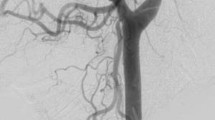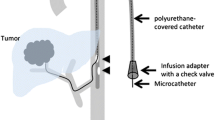Abstract
Locally or recurrent advanced breast cancers can receive arterial blood supply from various arteries, such as the internal thoracic artery (ITA), the lateral thoracic artery, and the other small arterial branches originating from the subclavian artery. Failure to catheterize and subsequent formation of collateral arterial blood supply from various arteries are some of the reasons why the response to conventional selective transarterial infusion chemotherapy is limited and variable. To overcome this problem, we developed a new subclavian arterial infusion chemotherapy method using an implanted catheter–port system after redistribution of arterial tumor blood supply by embolizing the ITA. We named this technique (“redistributed subclavian arterial infusion chemotherapy” (RESAIC)). Using RESAIC, patients can be treated on an outpatient basis for extended periods of time. Eleven patients underwent RESAIC, and the complete remission and partial response rate in 10 evaluable patients was 90%: complete remission [CR] n = 4, partial remission n = 4, stable disease n = 1, and not evaluable n = 1. Three of four patients with CR had no distant metastasis, and modified radical mastectomy was performed 1 month after conclusion of RESAIC. The resected specimens showed no residual cancer cells, and pathologically confirmed complete remission was diagnosed in each of these cases. Although temporary grade-3 myelosuppression was seen in three patients who were previously treated by systemic chemotherapy, there was no other drug-induced toxicity or procedure-related complications. RESAIC produced a better response and showed no major complications compared with other studies despite the advanced stage of the cancers.


Similar content being viewed by others
References
Haagensen CD (1986) Clinical classification of the stage of advancement of breast carcinoma. In: Haagensen CD (ed) Disease of the breast. W B Saunders, Philadelphia, pp 851–863
Japanese Breast Cancer Society (1989) The general rules for clinical and pathological recording of breast cancer. Jpn J Surg 19:612–632
Murakami M, Kuroda Y, Nishimura S, Sano A, Okamoto Y, Taniguchi T et al (2001) Intraarterial infusion chemotherapy and radiotherapy with or without surgery for patients with locally advanced or recurrent breast cancer. Am J Clin Oncol 24:185–191
Kitagawa K, Yamakado K, Nakatsuka A, Tanaka N, Matsumura K, Takeda K et al (2002) Preoperative transcatheter arterial infusion chemotherapy for locally advanced breast cancer (stage IIIb) for down-staging and increase of resectability. Eur J Radiol 43:31–36
Fiorentini G, Tsetis D, Bernardeschi P, Varveris C, Rossi S, Kalogeraki A et al (2003) First-line intra-arterial chemotherapy (IAC) with epirubicin and mitoxantrone in locally advanced breast cancer. Anticancer Res 23:4339–4345
Koyama H, Wada T, Takahashi Y, Iwanaga T, Aoki Y (1975) Intra-arterial infusion chemotherapy as preoperative treatment of locally advanced breast cancer. Cancer 36:1603–1612
Stephens FO (1990) Intraarterial induction chemotherapy in locally advanced stage III breast cancer. Cancer 66:645–650
Görich J, Hasan I, Majdali R, Sittek H, Kunze V, Doma A, ET AL (1995) Previously treated, locally recurrent breast cancer: treatment with superselective intraarterial chemotherapy. Radiology 197:199–203
Bufill JA, Grace WR, Neff R (1994) Intra-arterial chemotherapy for palliation of fungating breast cancer. A case report and review of the literature. Am J Clin Oncol 17:118–124
Pacetti P, Mambrini A, Paolucci R, Sanguinetti F, Palmieri B, Della Seta R, ET AL (2006) Intra-arterial chemotherapy: a safe treatment for elderly patients with locally advanced breast cancer. In Vivo 20:761–764
Seki H, Kimura M, Yoshimura M, Yamamoto S, Ozaki T, Sakai K (1998) Development of extrahepatic arterial blood supply to the liver during hepatic arterial infusion chemotherapy. Eur Radiol 8:1613–1618
Ymagami T, Kato T, Tanaka O, Hirota T, Nishimura T (2005) Influence of extrahepatic arterial inflow into the posterior segment or caudate lobe of the liver on repeated hepatic arterial infusion chemotherapy. JVIR 16:457–463
Arai Y, Inaba Y, Takeuchi Y (1997) Interventional techniques for hepatic arterial infusion chemotherapy. In: Castaneda-Zuniga WR (ed) Interventional radiology, 2nd edn. Williams & Wilkins, Baltimore, pp 192–205
Yamagami T, Kato T, Iida S, Tanaka O, Nishimura T (2004) Value of transcatheter arterial embolization with coils and n-butyl cyanoacrylate for long-term hepatic arterial infusion chemotherapy. Radiology 230:792–802
Padhani AR, Ollivier L (2001) The RECIST (response evaluation criteria in solid tumors) criteria: implications for diagnostic radiologists. Br J Radiol 74:983–986
Trotti A, Colevas AD, Setser A, Rusch V, Jaques D, Budach V et al (2003) CTCAE v3.0: development of a comprehensive grading system for the adverse effects of cancer treatment. Semin Radiat Oncol 13:176–181
Wang HC, Lo SS (1996) Future prospects of neoadjuvant chemotherapy in treatment of primary breast cancer. Semin Surg Oncol 12:59–66
Stoesslein F, Ditscherlein G, Romaniuk PA (1982) Experimental studies on new liquid embolization mixtures (histoacryllipiodol, histoacryl-panthopaque). Cardiovasc Intervent Radiol 5:264–267
Cakmakli S, Ersöz S, Tug T, Karaayvaz M, Akgül H (1997) Intra-arterial infusion chemotherapy in the treatment of locally advanced breast cancer. Acta Oncol 36:489–492
Grosso M, Zanon C, Mancini A, Garruso M, Gazzera C, Anselmetti GC et al (2000) Percutaneous implantation of a catheter with subcutaneous reservoir for intraarterial regional chemotherapy: technique and preliminary results. Cardiovasc Intervent Radiol 23:202–210
Author information
Authors and Affiliations
Corresponding author
Rights and permissions
About this article
Cite this article
Takizawa, K., Shimamoto, H., Ogawa, Y. et al. Development of a New Subclavian Arterial Infusion Chemotherapy Method for Locally or Recurrent Advanced Breast Cancer Using an Implanted Catheter–Port System After Redistribution of Arterial Tumor Supply. Cardiovasc Intervent Radiol 32, 1059–1066 (2009). https://doi.org/10.1007/s00270-009-9510-1
Received:
Revised:
Accepted:
Published:
Issue Date:
DOI: https://doi.org/10.1007/s00270-009-9510-1




